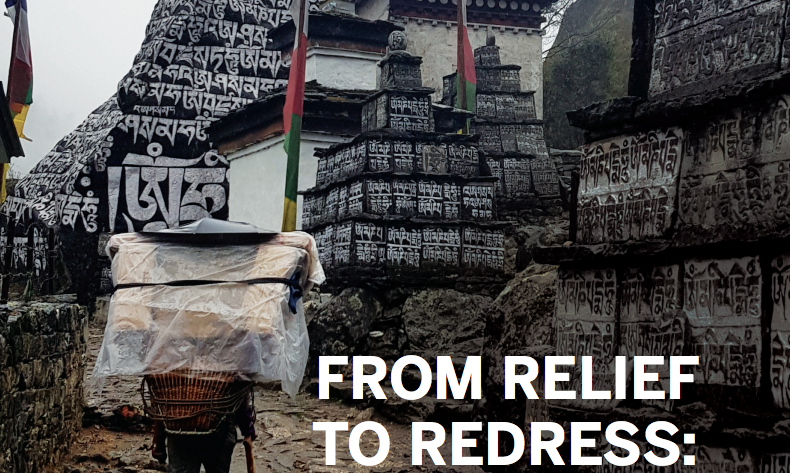Report: From Relief to Redress – Reparations In Post-Conflict Nepal
By Govinda Sharma, James Gallen, Luke Moffett and Laxmi Pokharel (Reparations Team)

Our new report on reparations in Nepal is now published – ‘From Relief to Redress: Reparations in Post-Conflict Nepal’. The report is available in English and Nepali.
Executive Summary
Between 1996-2006 Nepal’s civil war endured a prolonged, but low intensity conflict, with few single incidents involving large scale casualties. Nonetheless, over this period, a significant number of unlawful killings, estimated at 13,000, at least 1,300 enforced disappearances, and 200,000 displaced. In addition, a significant number of allegations of torture, inhuman and degrading treatment (2,500) persist. One significant data gap in a conflict as prolonged as in Nepal is regarding sexual and gender based violence, which it is believed remains significantly under-reported. The causes of the civil war are often understood to include a failure by political elites to effectively govern the country in a democratic fashion and to distribute political, economic and social goods in a non-discriminatory and non-patrimonial fashion. The underlying lack of accountability, good governance and the rule of law that may have contributed as grievances to the outbreak of armed conflict as well as successive People’s Movements in Nepal. However, these factors remain unaddressed and also influence the limitations of Nepal’s reparations schemes to date.
Nepalese law has several grounds on which individuals can claim compensation and reparation for harms and human rights violations related to the armed conflict. This diversity of sources and processes means that affected individuals and families have to navigate a range of state institutions and mechanisms to receive a remedy and can result in arbitrary and discriminatory treatment of victim-survivors of the conflict. Several schemes emerged during and after the armed conflict in Nepal, addressing those who lost family members through unlawful killing, enforced disappearance, those whose property or person was injured or destroyed during the conflict, and those affected as internally displaced persons. Each scheme has its own set of challenges regarding eligibility criteria, adequacy of payment and form of reparation and associated procedures. In addition, the mapping of these various schemes across the universe of potential victim-survivors creates significant arbitrary and discriminatory treatment.
Across the range of reparative schemes in Nepal, various agencies at the district level were responsible. As a result, a family that has overlapping multiple conditions of victimhood have to go through each of these procedures separately to access the different types of reparations. For example, the families of deceased and disappeared required to apply to the District Admiration Office (DAO), widows to the District Development Committee (DDC), injured and disabled to District Public Health Office (DHO), and scholarship scheme to the District Education Office (DEO). In addition, there have been little or no information at the village level about all these procedures.
The processes and procedures for reparations in Nepal are neither coherent, effective nor transparent in their operation. In particular, the administrative reparation measures seem to have influenced by the beneficiaries’ political access. For instance, the first scheme of relief (the IDP policy) was designed under the government of Nepali Congress and majority of the IDPs are perceived to belong to Nepali Congress party. Similarly, the financial assistance to those who were killed or disappeared was implemented while the Maoist party was leading the government. Majority victims of this category are perceived to belong to the Maoist and Nepali Congress party. Similarly, the reparative scheme addressing the pregnant combatants and injured and disabled former combatants were developed while Maoist were in the government.
In addition, the administrative reparation scheme excludes a certain group of victims of human rights violation who are entitled to receive reparations. For example, victims of sexual and gender based violence, torture, illegal detention and freedom of expression were not included. Similarly, the issues of child soldiers who have been disqualified during the verification process by the UNMIN are also excluded from the administrative reparative measures and the rehabilitation and integration process. They view themselves as victims of human rights violation since they were recruited while they were minors. They have also formed a separate group and advocating for their rights for reparation.
There remains significant potential for both the Truth and Reconciliation Commission (TRC) and Commission of Inquiry on Disappeared Persons (CoID) to more comprehensively address the issue of victimised perpetrators. Human rights violations occurred in Nepal in several contexts including as reprisals for prior wrongdoing. Though ex-combatant schemes have created eligibility criteria that exclude some ex-combatants on the grounds of wrongdoing, a more thorough and consistent approach to reparation for victim-survivors including complex victims is warranted in Nepal. Both Nepal’s ongoing Truth and Reconciliation Commission and Commission to Investigate Disappearances have a mandate to provide for recommendations regarding reparations for human rights violations. It remains possible that both organisations could offer a more consistent holistic and comprehensive approach to reparations for Nepal’s civil war harms, but it is still unclear whether the ongoing nomination process of the both commission would be able to ensure the credibility of the commission.
Download>


